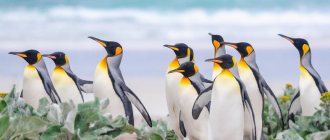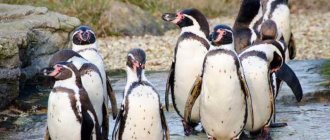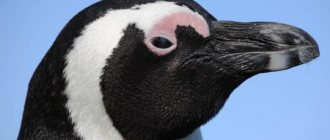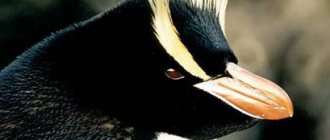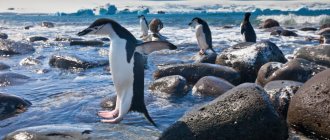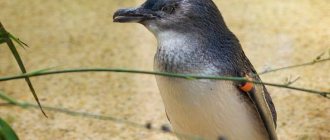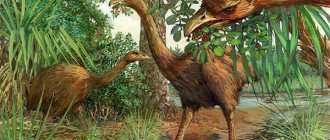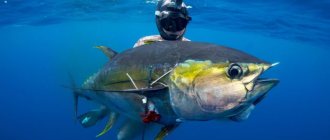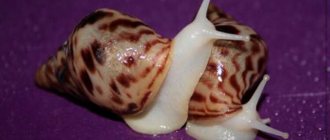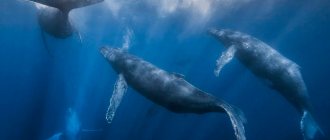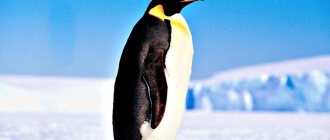Some people, when thinking about what animals live in Antarctica, immediately think of penguins, without even thinking that they are actually birds. Yes, seabirds that cannot fly, but dive and swim well in the water, and also walk on land in an upright position with a funny gait. Penguins are the most famous and numerous of all bird species that inhabit Antarctica. Their number is about 85% of the total number of all Antarctic birds. Of the entire penguin family, only two species live in Antarctica - Adélie penguins and emperor penguins.
Antarctica is the only continent on Earth where human presence is minimal, as living conditions here are very difficult. The fauna of Antarctica is directly related to its climate and is most common in the coastal zone. Penguins are quite comfortable here. They are even practically not afraid of people and allow guests to come close to them. One can only imagine what impressions and photographs with penguins you can bring back from a trip to Antarctica.
Origin of the name "penguin"
There are several versions of the origin of the name “penguin”. According to the first version, the word “penguin” was formed from two words of Welsh origin pen (head) and gwyn (white) and meant “great auk”, which is now considered extinct. It was black and white in color. Due to the similarity with this bird, the name was transferred to the penguin.
According to another version, the name “penguin” comes from the English word pinwing, which means “hairpin wing”. But this version is rather doubtful, since in English the word “penguin” is written as “penguin”.
According to another version, the name “penguin” comes from the Latin word “pinguis”, which means “thick”. This version is confirmed by the fact that in many European languages the word “penguin” is associated with the word “fat”.
Regarding the name of the emperor penguin species, it emphasizes the large size of this bird, even a record among living penguins. The Latin species name Aptenodytes forsteri of emperor penguins is given in honor of the German scientist Johann Forster. The Adelie penguin (Latin name Pygoscelis adeliae) was named by French explorer Jules Dumont-D'Urville in honor of his wife Adélie.
Penguin habitat
The predecessors of penguins lived in a temperate climate when Antarctica was not yet a glacier. As a result of climate change on the planet, the continents began to drift, Antarctica moved to the South Pole and became covered with eternal ice. Animals from there left the territory or became extinct, but penguins adapted to the cold and remained. Only before there were much more of them. At least 40 species of penguins have become extinct over the course of evolution. Currently, the penguin family includes 18 species of birds.
The geographical distribution of penguins is quite extensive, but they prefer cool weather. Penguins live in the open seas of the Southern Hemisphere, namely in the coastal waters of Antarctica, southern Australia, New Zealand, South Africa, along the entire coast of South America and on the Galapagos Islands near the equator.
The largest concentration of penguin individuals is located in Antarctica and on the adjacent islands. There are only two members of the penguin family that live in Antarctica: the emperor penguin and the Adélie penguin. Of all the penguin species, only the emperor penguin travels farthest south. About 300 thousand individuals of this species live on ice floes around Antarctica, but move to the mainland to mate and hatch eggs. Adélie penguins nest on the coast of Antarctica and the islands closest to the mainland: South Shetland and Orkney. Representatives of this species are quite rare north of 60 degrees south latitude.
Spectacled or donkey penguins
Spectacleds are a species of penguin that nest far from Antarctica. For their piercing cry, similar to the roar of a four-legged domestic animal, they are often called donkeys. A contrasting stripe with uneven edges, similar to a large arch, runs along the ventral part of the body.
- Spectacled penguin. The population size is estimated at approximately 200 thousand individuals. Although a century earlier there were about a million birds of this species.
- Humboldt penguin. In Chile and Peru, where cold currents touch rocky shores, Humboldt penguins hatch their chicks. There are not many birds left - about 12,000 pairs. Scientists attribute the decrease in the number of penguins to changes in the paths of sea currents.
- Magellanic penguin. Its name immortalizes the memory of the traveler Fernand Magellan. Birds inhabit the very south of South America, the shores of Patagonia. There, 2 million loud couples have offspring.
- Galapagos penguin. A species that nests in the Galapagos, that is, on the islands near the equator. Despite the striking difference in living conditions, Galapagos penguins have not undergone changes in appearance and habits compared to other spectacled birds.
General characteristics of penguins
All penguins are excellent swimmers and divers, but they do not have the ability to fly, like many birds. On land, the penguin looks rather awkward due to the special structure of the body and limbs. This bird has a streamlined body shape with well-developed muscles of the pectoral keel, which often makes up a quarter of the total mass. The penguin's body is plump, slightly laterally compressed and covered with feathers. The not very large head is located on a mobile, flexible and short neck. The beak of this bird is strong and sharp.
As a result of evolution and lifestyle, the penguin's wings have changed into elastic flippers. When swimming underwater, they work in the shoulder joint on the principle of a screw. The penguin's legs are short and thick, with four toes, which are connected by swimming membranes. Compared to other birds, the penguin's legs are set back, which forces it to hold its body upright while on land. To maintain balance, this bird is helped by a short tail, which consists of 16-20 hard feathers. When the need arises, the penguin simply leans on it like a stand.
The penguin's skeleton does not consist of long bones, which are typical for birds to fly. Penguin bones are more similar in structure to the bones of mammals. For thermal insulation, the penguin has a 2-3 cm layer of fat, above which there are several layers of short, waterproof feathers that fit tightly and are evenly distributed throughout the body. Small and short feathers that cover the bird's body like tiles protect it from getting wet in cold water. The feather color of all species is almost the same: black back and white belly.
Penguins molt once a year. At this time, new feathers grow at different rates and thereby push out the old feather. Often during the molting period, these birds have an unkempt appearance, are only on land, try to hide from gusts of wind and do not eat anything at all.
Social structure and reproduction
Photo: Emperor penguin chick
Penguins tend to form strong, long-lasting pairs. A pair is formed on the initiative of the female. She chooses her own companion, leaving no chance for other, less successful males. Then the female begins to very beautifully care for the male. First, she lowers her head, spreads her wings and begins to sing songs. The male sings along with her in unison. In the process of mating chants, they recognize each other by voice, but do not try to sing louder than others, so as not to interrupt the singing of others. Such courtship lasts almost a whole month. The pair moves one after another, or performs peculiar dances with beaks thrown back upward. The entry into marriage is preceded by a series of mutual bows.
At the end of April or in May, the female lays one egg. Its weight is 430-460 grams. Before laying an egg, she does not eat anything for a month. Therefore, after the mission is completed, she immediately goes to sea for food. She stays there for about two months. During this entire period, the future father looks after the egg. He places the egg in a fold of skin between the lower limbs, which acts as a pouch. No amount of wind or frost will force the male to leave the egg. Males without families pose a threat to future fathers. In a fit of rage, they can take the egg away or break it. Due to the fact that fathers treat their offspring so reverently and responsibly, more than 90% of eggs
Males lose significant weight during this period. At this moment, their weight does not exceed 25 kilograms. The female returns when the male experiences an unbearable feeling of hunger and calls her back. She returns with supplies of seafood for the baby. Next is daddy’s turn to rest. His rest lasts approximately 3-4 weeks.
For the first two months, the chick is covered in down and is unable to survive in the harsh climate of Antarctica. He exists only in the warm, cozy pocket of his parents. There the temperature is constantly maintained at least 35 degrees. If, by a fatal accident, the cub falls out of the pocket, instant death awaits it. Only with the arrival of summer do they begin to move independently and learn to swim and get their own food.
Penguins of Antarctica
The emperor penguin is the largest and heaviest of all penguin species. On average, the height of a male emperor penguin is 120 cm, and it weighs 35-40 kg, but the maximum weight of a male can reach 50 kg. Females reach only 115 cm in height and 35 kg in weight. The emperor penguin's muscular mass is also the largest of any bird species. The plumage of the emperor penguin is black on the back and head, and white on the chest, which makes it less noticeable to enemies in the water. They have a yellow-orange coloration on their cheeks and under the neck. Emperor penguin chicks are covered with white or grayish-white down.
Adélie penguins are the most numerous of the penguins of Antarctica. The Adelie penguin is somewhat more modest in size compared to the emperor penguin. Its height is up to 70 cm and weighs about 6 kg. Male and female Adelie penguins do not differ in color. They have a black head, neck and back, a white rim around the eyes and a white belly. Adélie penguins spend the winter on glaciers in the sea, and in early spring they come to land to breed. Adelie penguins are very trusting, they are not afraid of people.
What types of penguins are there and where do they live?
They all live along the shores of the cold southern oceans, many in icy Antarctica. A penguin is a sea bird that can swim well, but cannot fly at all! The pygmy penguin, which lives in Australia and New Zealand, is the smallest on the planet.
Interesting materials:
What happens if you swap the battery terminals? What happens if you put the battery in reverse? What happens if you wash a fluffy blanket? What happens if you constantly brush your teeth? What happens if you turn off your computer while installing Windows? What happens if you lose to Gunther and Dima? What happens if you miss a mark on the stock exchange? What happens if you miss taking prednisolone? What happens if you post advertisements? What happens if you eat a lot of cherry seeds?
Feeding of Antarctic penguins
Penguins feed on fish, plankton, and crustaceans. They eat Antarctic silverfish, sardines, anchovies, and krill. During one hunt, a penguin can make from 190 to 900 dives, this depends on the type of penguin, food needs, and climatic conditions. The bird's oral apparatus functions on the principle of a pump: through its beak, the penguin sucks in small prey along with water. On average, birds travel up to 27 km while feeding and spend 1.5 hours a day at a depth of over 3 m. The speed of penguins in water can reach 7-10 km per hour. Some species of penguins can dive to depths of over 100 m.
Regarding quenching thirst, penguins are perfectly adapted to life in the absence of liquid fresh water. They can drink sea salt water. The salt balance in the penguin's body is restored with the help of special supraorbital glands, which remove excess salt.
Heat-loving
In the photo: Galapagos penguin. Author: Derek Keats.
Antarctic species can withstand cold temperatures down to -60°C, but the Galapagos species is used to living in warmth. They live on islands where the air temperature reaches +28°C, and swim in warm water of +22–24°C.
This species is small. Adults grow no more than 50 cm and weigh from 2 to 2.5 kg. The head and back are black, but the belly is white. There are small pink circles around the eyes.
Peruvian
The second name of this species is Humboldt penguin, and it lives among the rocks of Peru and Chile. Considered an endangered species. The main reason for the population decline is changes in the Pacific Current system.
They differ from others in their unique color. There is a dark stripe running along the white chest, and around the eyes there are, as if painted, dark “glasses.”
Movement of Antarctic penguins
During the period when penguins are not busy with mating games and caring for offspring, they can swim far from the coast at a distance of several tens of kilometers. When leaving the water, penguins can jump from the height of the coastline to 2 m. Due to the fact that these birds have short legs, penguins on land waddle from side to side - this method of movement has been proven to save energy. On land, penguins reach speeds of 3 to 6 km/h. Also on ice, these birds can move quickly: they lie on their stomachs, push off with their limbs and slide down the mountains. Some species travel in this way a long distance between the sea and the place where their colony is based. The lifespan of penguins is 25 years or more.
The secret is in the thick feathered body
After all, penguins are flying birds, but they fly underwater. And they fly very well. If you catch something underwater for 60 million years, it will have a good effect on you. A thin beak cuts through the water, turning into a thick but streamlined body that descends onto thin legs. Penguins also swim using their wings. This is a high specialization for moving underwater. The penguin's wing bones became flat and the wings became flippers, similar to the flippers of eared seals.
Penguins also jump “like a dolphin”; it is believed that this also speeds them up, since the resistance in the air is less than in the water. They have features in the structure of their plumage. Feathers, unlike other birds, have a very high density per unit surface area. They are short and close to the body. Moulting penguins cannot swim because they will freeze. The short, dense tail increases streamlining, and there are no unnecessary turbulences. This plumage is somewhat similar to skin.
Enemies of the penguins of Antarctica
In their natural habitat, penguins have enemies. Adult birds in the sea are hunted by leopard seals, killer whales, fur seals and sea lions, as well as sharks. Especially these species of seals often control shallow waters near penguin colonies, when the birds cannot use their advantage - maneuverability. According to experts, up to 5% of all Adelie penguins die in this way each year.
On sushi, seagulls happily peck penguin eggs, and helpless chicks are a tasty prey for the Antarctic skua. Penguins also have to protect their brood from the petrel. Due to his fault, up to 35% of young emperor penguins die in different years.
Despite the fact that penguins are adapted to water, the presence of enemies in the sea is a cause of fear in birds. Before entering the water, they approach the shore slowly in small groups, as no one wants to be the first to enter the sea, this is the so-called penguin effect. This event can last up to half an hour. Once one brave penguin finally jumps into the water, the rest go after him.
Features of character and lifestyle
Photo: Emperor penguins in Antarctica
Penguins are not solitary animals; they live in group conditions and create strong pairs that last throughout the life of the birds.
Interesting! Penguins are the only birds in existence that do not know how to build nests.
They lay eggs and hatch offspring, hiding behind natural shelters - rocks, cliffs, ice, etc. Almost two months a year are spent at sea in search of food, the rest of the time is spent incubating eggs and hatching offspring. Birds have a very developed parental instinct. They are considered excellent, very sensitive and caring parents.
Birds can move on land on their hind limbs, or lying on their stomachs, moving their front and hind limbs. They walk slowly, slowly and very awkwardly, since their short lower limbs do not bend at the knee joint. They feel much more confident and agile in the water. They are able to dive deeply and reach speeds of up to 6-10 km/h. Emperor penguins emerge from the water, making amazing leaps up to several meters long.
These birds are considered very cautious and timid. Sensing the slightest approach of danger, they rush in all directions, leaving eggs and their offspring behind. However, many colonies are very welcoming and friendly towards people. Often they are not only not afraid of people, but also look at them with interest, and even allow them to touch themselves. Complete matriarchy reigns in bird colonies. Females are leaders; they choose their own males and seek their attention. After a pair has formed, the males incubate the eggs, and the females go hunting.
Emperor penguins are very resistant to severe frosts and strong winds. They have quite developed subcutaneous fatty tissue, as well as very thick and dense plumage. To keep warm, the birds form a large circle. Inside this circle the temperature reaches +30 at an ambient temperature of -25-30 degrees. In the center of the circle there are often cubs. Adults change places, moving from the center closer to the edge, and vice versa.
Lifestyle of Antarctic penguins
The penguins of Antarctica have completely unique characteristics that are associated with their social life. Penguins live in large groups or colonies. And during the cold winter they practice an interesting way of heating. All the birds gather in a huge flock, which makes slow circular movements, that is, they move in a circle.
Inside this so-called penguin house it is very warm and cozy, the cold wind does not get in there, and neighboring individuals warm each other. But on the outskirts it is no longer so comfortable. To prevent any of the colony penguins from freezing, they slowly change places. The outermost individuals gradually approach the center, and the warmed birds move to the periphery. The penguin squeezes through the colony, its flippers slightly extended and its beak raised. This is the name for the “peaceful” position of the body, which helps it avoid aggression from other birds.
Penguins have an amazing peacefulness and consciousness for such a survival system to be beneficial. This is a special case in the animal kingdom when personal gain is sacrificed for the good of the public.
Population and species status
Photo: Female emperor penguin
A significant threat to the emperor penguin population is climate change and warming. Rising temperatures lead to the melting of glaciers, that is, the destruction of the natural habitat of birds. Such processes lead to a decrease in the birth rate of birds. Due to climate change, certain species of fish, shellfish, and crustaceans are becoming extinct, which means the food supply of penguins is decreasing.
Humans and their activities play a large role in the disappearance of emperor penguins. People exterminate not only penguins, but also catch fish and other inhabitants of the deep sea in large quantities. Over time, the number of species of marine life is constantly decreasing.
Recently, extreme tourism has become very common. Lovers of new sensations go to the most inaccessible and uninhabited places on the globe. Antarctica is no exception. In this regard, the habitat regions of emperor penguins are becoming clogged.
